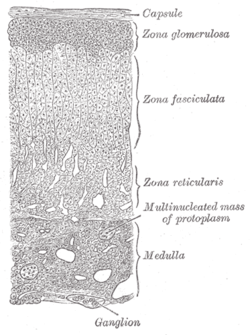- Medullary chromaffin cell
-
Medullary chromaffin cell 
Adrenal gland. (Medulla labeled at bottom right.) Latin endocrinocytus medullaris Code TH H3.08.02.6.00015 Chromaffin cells are neuroendocrine cells found in the medulla of the adrenal gland (suprarenal gland, located above the kidneys) and in other ganglia of the sympathetic nervous system. They are modified post-synaptic sympathetic neurons that receive sympathetic input. Instead of releasing neurotransmitter (catecholamines - ~20% Norepinephrine (Noradrenaline) and ~80% Epinephrine (Adrenaline)) to an adjacent organ or tissue for a specific effect, neurotransmitter is released into systemic circulation for systemic effects on multiple organs. Hence they are called neuroendocrine cells.
In the fifth week of (human) fetal development, neuroblast cells migrate from the neural crest to form the sympathetic chain and preaortic ganglia. The cells migrate a second time to the adrenal medulla. Chromaffin cells also settle near the sympathetic ganglia, vagus nerve, paraganglia, and carotid arteries. In lower concentrations, extra-adrenal chromaffin cells also reside in the bladder wall, prostate, and behind the liver.
Contents
Function
Chromaffin cells of the adrenal medulla are innervated by the splanchnic nerve and secrete adrenaline (epinephrine), noradrenaline (norepinephrine), and enkephalin and enkephalin-containing peptides into the blood stream. The secreted adrenaline and noradrenaline play an important role in the fight-or-flight response. The enkephalins and enkephalin-containing peptides are related to, but distinct from endogenous peptides named endorphins (which are secreted from the pituitary); all of these peptides bind to opioid receptors and produce analgesic (and other) responses. The hormones are secreted from granules; this is where the enzyme dopamine β-hydroxylase catalyzes the conversion of dopamine to noradrenaline. Distinct N and E cell forms exist (also Na and A cells in British nomenclature - noradrenaline and adrenaline); the former produce norepinephrine, the latter arise out of N cells through interaction with glucocorticoids, and convert norepinephrine into epinephrine.[1]
Nomenclature
These cells are so-named because they can be visualized by staining with chromium salts. Chromaffin salts oxidize and polymerize catecholamines to form a brown color, most strongly in the cells secreting noradrenaline.
(The enterochromaffin cells are so named because of their histological similarity to chromaffin cells (they also stain yellow when treated with chromium salts), but their function is quite different.)
References
External links
- Histology at BU 14507loa - "Endocrine System: adrenal gland, reticularis and medulla"
- Secretion Control in Adrenal Chromaffin Cells
- UC-San Diego Chromaffin Cell and Hypertension Research
- A Primer on Chromaffin Cells
- Rat Chromaffin cells primary cultures: Standardization and quality assessment for single-cell assays (a protocol)
Human anatomy, endocrine system: endocrine glands (TA A11, TH H3.08, GA 11.1269) Islets of pancreas Hypothalamic/
pituitary axes
+parathyroidPituitaryPars intermedia · Pars tuberalis · Pars distalis
Acidophil cell (Somatotropic cell, Prolactin cell) · Basophil cell (Corticotropic cell, Gonadotropic cell, Thyrotropic cell) · Chromophobe cellThyroid isthmus · Lobes of thyroid gland · Pyramidal lobe of thyroid gland
Follicular cell · Parafollicular cellMedullary chromaffin cellPineal gland Other Enteroendocrine cell · ParagangliaHuman cell types / list derived primarily from ectoderm Surface ectoderm Trichocyte · KeratinocyteNeural crest glia: Schwann cell · Satellite glial cellDigestive systemNeural tube Categories:- Medicine stubs
- Neuroendocrine cells
- Human cells
Wikimedia Foundation. 2010.


